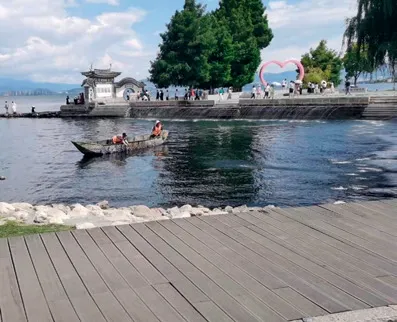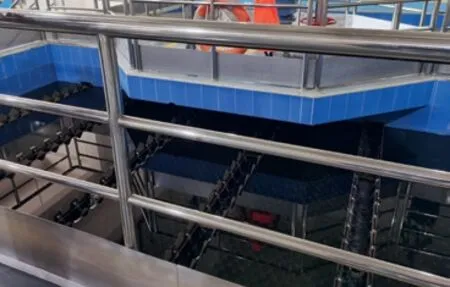CLEARER AND BETTER
2022-09-06EnvironmentalprotectionofErhaiLakeseessteadyprogressByLiXiaoyang
Environmental protection of Erhai Lake sees steady progress By Li Xiaoyang
is a kind of aquatic plant that grows in freshwater lakes in China’s southern regions. Its flowers have white petals on a yellow base, and the plant is an indicator of good water quality. Once endangered, the species is now thriving in Erhai Lake, a famous tourist attraction in Yunnan Province.
With an area of 250 square km,Erhai is about one and a half times the size of Washington, D.C. in the United States. It is the main source of drinking water for Dali Bai Autonomous Prefecture. In recent years, efforts by the local government and other groups to improve the lake’s ecology have been paying off.
Since 2018, local authorities in Dali have been building an environmental protection system, known as the Erhai Ecological Corridor, to reduce pollution and to restore the lake’s natural ecosystem. The lake used to be severely polluted due to the rapid expansion of tourism and development of the local economy, with many inns opening right beside the lake.
The project includes building a 129-km road around the lake, developing a pipe system to stop sewage from flowing into the lake, relocating 1,806 households in the protection area, restoring the wetlands and ecosystem,and improving wetland restoration research. With a total investment of 9.8 billion yuan ($1.45 billion), the project is sponsored by the government of the prefecture.
As of late 2021, the water quality of 23 rivers flowing into Erhai reached the level of Grade II, according to the prefecture’s government. Surface water quality is categorized into five grades in China, with Grade I being the best. Grade-II level water can be used for drinking after treatment. The road along the lake has become a hotspot for sightseeing, with tourists riding bicycles to appreciate the now much bluer body of water; it has also facilitated local people’s transportation.
Li Zhixian, a ranger working in the wetlands of Erhai has witnessed the improvement of water quality. She started working in the wetlands in 2007. “We used to find a lot of plastic garbage in the lake... Now, no more white garbage can be seen in the lake. Locals’ awareness of environmental protection has also been enhanced. As a local resident, I’m glad to see these changes. Our living environment is improving,” she told.
Relocation for protection
Yang Kuifa, in his 50s, used to operate two inns near Erhai. In 2018, the government of Dali began relocating residents living and operating businesses along the lake.The 1,806 households have been relocated to five new townships.
As planned, a total of 138 households will be relocated to Yinqiao Township. As of this August, 33 families had already moved in. Each household received around 4 million yuan ($594,928) in compensation, including new housing, from the government. While some of them used to be fishermen, there are also others like Yang who operated inns along the lake.
Yang moved to Yinqiao Township earlier this year.One of his inns in the protection area, with annual revenue of 2 million yuan ($297,464), was demolished. “Although there are losses for me, I understand protecting the ecological environment is a priority,” Yang told.
The new three-storied house has a floor space of 400 square meters. Schools and hospitals are easily accessed in the surrounding area, Yang said. He now mainly focuses on the businesses of an inn outside the preserved area of the lake.
According to Li Siyuan, Deputy Mayor of Yinqiao Township, the relocated residents have shifted to jobs in the secondary and tertiary industries.They can also rent out their vacant rooms in the township for extra income. The government has provided skill training for them, and introduced them to local enterprises, such as Wahaha, a Chinese beverage brand.
Improving waste disposal
In addition to tourism, the pollution of Erhai was also caused by sewage and garbage generated in the daily life and agricultural activities of rural households. Erbin is one of the villages along the lake. According to Li Hongfang, Deputy Director of the Erbin Villagers Committee, sewage from kitchens and bathrooms of rural households affects the water quality of Erhai. The villages each had a treatment facility but their capacity was insufficient to cope with fluctuations in use. Prefecture-levelauthorities took over the responsibility for treating poluted water in 2015.

Rangers in a boat collect garbage and aquatic weeds in Erhai Lake, Yunnan Province, on August 6

The water treatment system of Dali Erhai Ecological Environment Protection Co. Ltd. in Yunnan on August 6
The government created a centralized network for water treatment. The sewage is collected village by village,and then sent to the Dali Erhai Ecological Environment Protection Co. Ltd. for treatment. The company is a subsidiary of China Water Environment Group Ltd., a leading investor and operator in water environment management.
According to Li Jianjun, Deputy General Manager of the DEEEP, the company has invested nearly 6 billion yuan ($890.2 million) in developing the water disposal system since 2015.The project was completed in 2018 and began operating in January 2019. The system includes 12 water treatment plants, which serve approximately 370 villages whose total population exceeds 170,000 and can treat 210,000 cubic meters of sewage per day. Of the water treatment plants, six are underground.
“In 2015, the quality of treated water reached Grade III for seven months and Grade II for five months of the year. After the treatment was initiated,the quality of treated water reached the level of Grade II for seven months annually in 2019-21. The treated water flows into wetlands and reservoirs, and is then purified again and some is used for irrigating surrounding farmlands.The remainder flows into the Xi’er River, which is connected to Erhai,” Li Jianjun told.
Li Jianjun said the underground water treatment facilities save space and reduce carbon emissions, compared with factories above the ground.Lands above these facilities serve as parks or other venues for tourists.
The company has launched smart water treatment systems and set up real-time monitoring of pollution levels. It collects data on pollution and alerts staff to sections of the waterway at risk of water quality deterioration.The company has also developed its own technology to deodorize the water in underground plants, which improves the working environment for its employees and enhances water quality.
“The water quality of Erhai is expected to get even better this year. Our long-term goal is to make the water quality reach the Grade-II level all year round,” Li Jianjun said. BR
